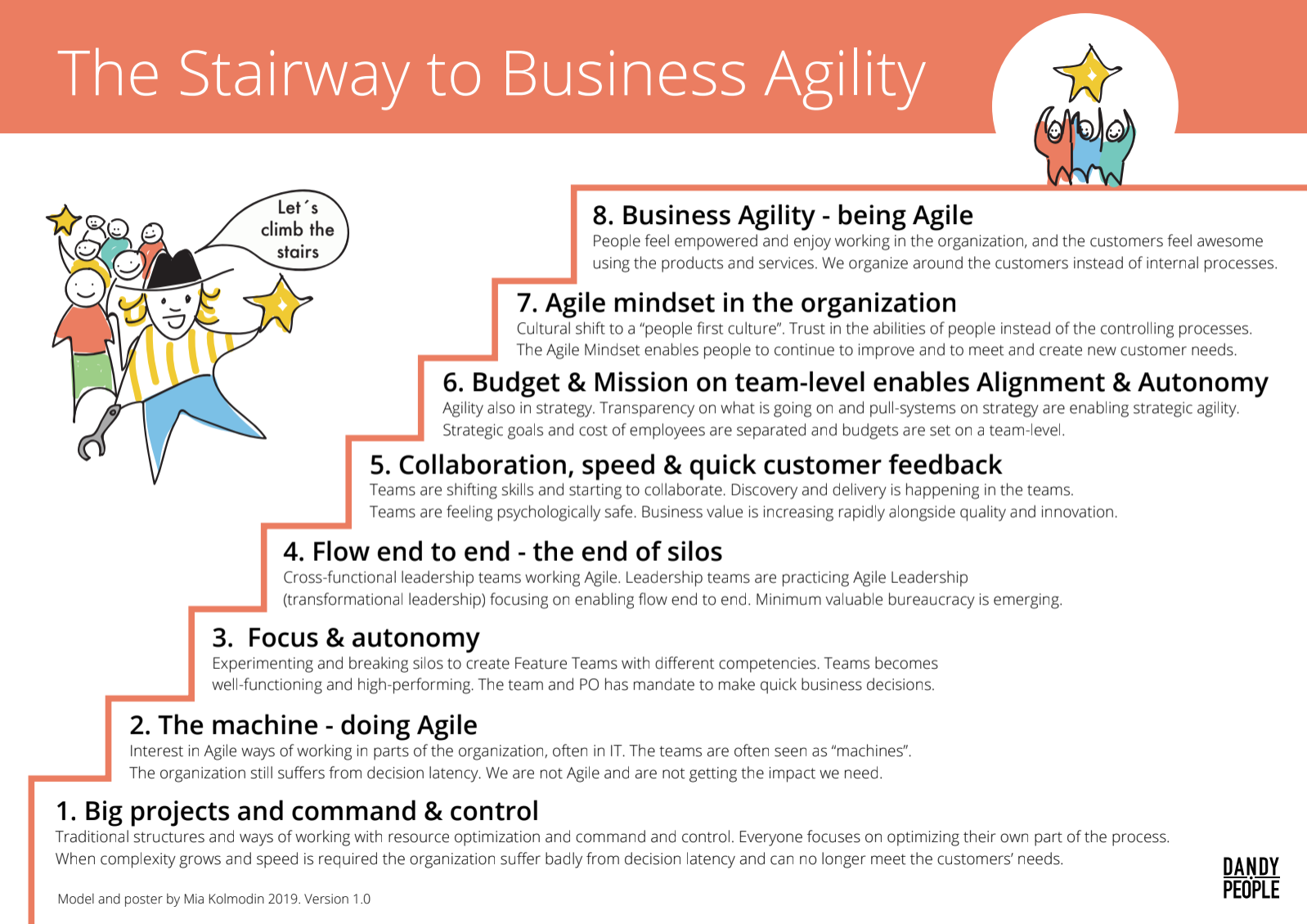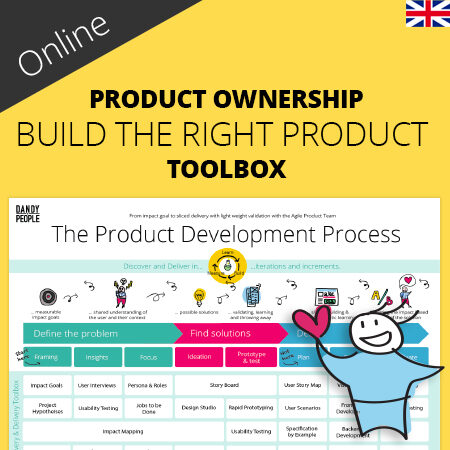Many organizations right now are moving from viewing the organizations as a machine to a people first culture, enabling valuable collaborations, strategic flexibility and customer focus. The Stairway to Business Agility can be used as a tool for self- and shared reflection. It is based on experiences from many different organizations and their journey towards a well functioning and high performing organizations. You might have totally different experiences, and thats fine too.
Where are you and your organization today?
Are you doing Agile – or being Agile, and what is your ambition? You will probably find that you partly might be on different steps at the same time, in different parts of the organization, and that you might have done some things that in this visualization “belongs” on another step. That is not wrong, we should work in parallells and not in a waterfall implementation manner. Perhaps you can find even more things that you can do to enable business Agility by looking at this as inspiration and take some time to reflect together. Please skip the steps in the bottom now that you know they don’t bring the value we usually are looking for when going Agile.
Download the Stairway to Business Agility as high resolution PDF here >
Let’s start at the bottom of the stairs where we are non Agile.
1. Big projects and command & control
Resource optimization and command and control. Everyone focuses on optimizing their own part of the process, running bigger and bigger projects and making sure everyone is as occupied as possible. Complexity grows, you are hiring more people – but it takes longer and longer while you deliver even less with worse quality. We suffer badly from decision latency and can no longer meet the customers’ needs. The management models that have served the organization well the past 100 years is no longer giving us what we need and we are starting to feel the pain of it.
2. The machine – doing Agile
Interest in Agile ways of working in parts of the organization. Some teams in parts of the organization start to work Agile, often in IT. This often leads to positive effects for the people involved, but since it is a sub optimization of a small part of the process, it rarely creates any real business or customer value and it may even lead to disengagement in the teams after a while. The teams are often seen as “machines”. The teams may be working with Scrum or Kanban with Agile artifacts, but the projects may still run just like before with lots of upfront planning and handovers, with heavy and opaque prioritization processes and lots of bureaucracy. People are still seen as “resources” by many, Teams often don’t have the mandate to make decisions on what or how to do things, making them deliver on the “full scope” instead of solving the problem. The effect of this is debt both technically, in usability and in products. The organization still suffers from decision latency. We are not Agile and are not getting the impact we need.
3. Focus & autonomy
Experimenting and breaking silos to create Feature Teams. Bringing new people with different competencies to the teams as well as Product Owners with the mandate to make business decisions often brings the teams closer to the customer. Teams struggle with maturity issues that leads to conflicts and makes collaboration difficult due to old non-agile methods and roles within the team. Improved business impact is still difficult to see, even though the focus in the teams and the mandate to make tactical decisions makes some of the positive effects of Agile ways of working visible to both the people involved and customers. The more experience and support the team gets, the faster the process of building well-functioning and high-performing teams becomes.
4. Flow end to end, the end of silos
Cross-functional leadership teams working Agile. Managers from different parts of the organization are joining the same leadership teams and are practicing Agile Leadership (transformational leadership), understanding and using the Agile principles to adapt the management structures to enable flow end to end. When leaders collaborate with a shared vision it enables all employees to collaborate and achieve focus as well as flow end to end (high speed/low lead times).
All leadership teams are removing structural impediments by asking teams what needs to improve to increase flow and value, and makes that happen as soon as possible. Minimum valuable bureaucracy is emerging.
5. Collaboration, speed & quick customer feedback
Shifting skills and starting to collaborate. Teams are feeling psychologically safe. Team members are shifting methods to ways of working that enable collaboration and smaller, valuable deliveries. Sharing competencies and building T-shape are part of the teams’ daily agenda and becomes part of their ways of working, and other roles than Agile roles are no longer valuable to the team. The teams are increasing their speed of deliveries thanks to the ability to work on what’s most important, which enables the team to get continuous feedback from real customers and they can make smart and quick tactical decisions. Business value is starting to increase rapidly alongside quality and innovation. The teams are well-functioning and high-performing.
6. Budget and Mission on team-level enables Alignment & Autonomy
Agility also in strategy. Transparency on what is going on and pull-systems on strategy are enabling strategic agility. Teams looks at what is strategically important for the business and set their team Mission for 3-12 months to deliver on those strategies. Strategies, deliveries and impediments are visualized by the leadership teams. Missions are re-visited and adjusted if and when needed. Strategic goals and cost of employees are separated and budgets are instead set on a team-level, which enables strategies to shift whilst keeping the teams more fixed and high-performing over time. Skills are shifted in teams continuously to support shifts in strategies.
7. Agile mindset in the organization
Cultural shift to a “people first culture”. Trust in the abilities of people instead of the controlling processes, and the cultural shift is here. The Agile mindset enables the people of the organization to continue to improve and to meet and create new customer needs.
8. Business Agility – Being Agile
A flexible organization that always is evolving and adapting enables us to take on whatever opportunities and challenges the future may bring us. People feel empowered and enjoy working in our organization, and our customers feel awesome using our products and services. We organize around the customers instead of internal processes and we shift our strategies quickly and adapt to or create new customer needs.
This is business agility – an organization fit for the future!
Download the Stairway to Business Agility as high resolution PDF here >
Free to download, use and share
The posters is published under Creative Commons License, so please use it and share it as you like. If you are interested in doing a translation to any other languages please let me know and I will help you with the file and publish it here in the blog as well.
You are free to:
Share — copy and redistribute the material in any medium or format
Adapt — remix, transform, and build upon the material for any purpose, even commercially.
This license is acceptable for Free Cultural Works.
The licensor cannot revoke these freedoms as long as you follow the license terms.
Under the following terms:
Attribution — You must give appropriate credit, provide a link to the license, and indicate if changes were made. You may do so in any reasonable manner, but not in any way that suggests the licensor endorses you or your use.
ShareAlike — If you remix, transform, or build upon the material, you must distribute your contributions under the same license as the original.
No additional restrictions — You may not apply legal terms or technological measures that legally restrict others from doing anything the license permits.
Here you find all the other Free Agile in a Nutshell-posters in the series that are now translated to 14 languages and downloaded over 70.000 times world wide.




